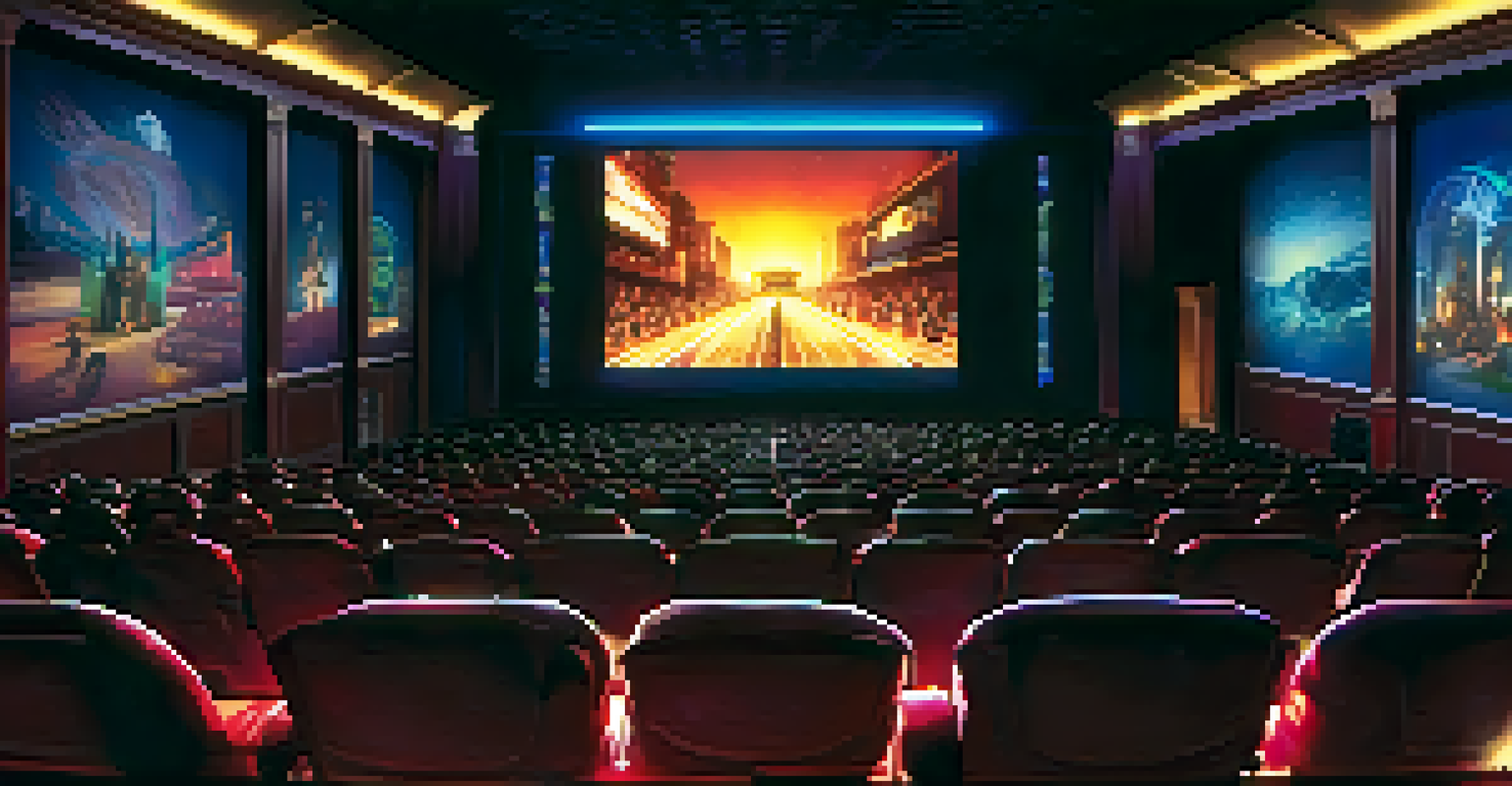Understanding the Basics of Film Marketing in Hollywood

The Importance of Film Marketing in Hollywood
In the bustling world of Hollywood, film marketing plays a vital role in a movie's success. With countless films released each year, effective marketing can be the difference between box office hits and flops. It's not just about promoting a film; it's about creating a buzz and building anticipation among audiences.
Marketing is no longer about the stuff you make, but the stories you tell.
Marketing strategies help filmmakers reach their target audience through various channels, from social media to traditional advertising. This engagement is crucial, as it shapes public perception and influences ticket sales. A well-executed marketing campaign can elevate a film's status before it even hits the theaters.
Ultimately, the goal of film marketing is to ensure that a movie resonates with its intended audience. It's about telling a compelling story that extends beyond the film itself, reaching into the hearts and minds of viewers even before they see it.
Understanding Target Audiences in Film Marketing
Identifying the target audience is a cornerstone of effective film marketing. Filmmakers must understand who their film is for—age, interests, and viewing habits all play a role in shaping marketing strategies. For instance, a family-friendly animated film will target a different demographic than a gritty thriller.

Once the target audience is determined, marketers can tailor their messages and choose the right channels to reach these viewers. This might involve social media campaigns on platforms like Instagram for younger audiences or more traditional ads for older demographics. Knowing where your audience spends their time is crucial for maximizing engagement.
Film Marketing Drives Box Office Success
Effective film marketing creates anticipation and buzz, crucial for a movie's performance at the box office.
Furthermore, understanding the audience enables marketers to create content that resonates with viewers on a personal level. By tapping into emotions, shared experiences, or cultural touchpoints, they can form connections that drive interest and attendance.
Key Strategies in Hollywood Film Marketing
Film marketing in Hollywood employs a variety of strategies to captivate audiences. One key approach is the use of trailers, which serve as a sneak peek into the film's storyline and style, enticing viewers to want more. These trailers are typically released months before the film's premiere to build anticipation.
The best marketing doesn't feel like marketing.
Another strategy involves utilizing social media influencers and celebrities to promote the film. Their large followings can create significant buzz and reach a wider audience, making them valuable assets in marketing campaigns. Engaging with fans through Q&A sessions or behind-the-scenes content can also enhance this connection.
Lastly, event marketing, such as premieres and film festivals, creates excitement around a project. These events not only attract media attention but also allow filmmakers to engage directly with audiences, generating word-of-mouth promotion that can be incredibly effective.
The Role of Social Media in Film Marketing
In today's digital age, social media has transformed the landscape of film marketing. Platforms like Twitter, Instagram, and TikTok allow filmmakers to connect directly with audiences, creating a two-way conversation that builds community and interest. These channels are not just for promotion; they are vital for engaging fans and fostering loyalty.
Social media campaigns often include interactive content, such as polls, challenges, and live streams, which keep audiences engaged and excited about upcoming releases. For example, a film might launch a hashtag challenge on TikTok that encourages users to create their own content related to the movie.
Understanding Audiences is Key
Identifying and targeting the right audience allows marketers to tailor their strategies for maximum engagement.
Moreover, social media provides real-time feedback, allowing marketers to adjust their strategies based on audience reactions. This agility in marketing can lead to more effective campaigns that resonate with viewers and enhance overall interest in the film.
The Impact of Trailers and Teasers
Trailers and teasers are perhaps the most significant tools in film marketing. They serve as the first glimpse into a film's universe, showcasing key scenes, characters, and the overall tone. A well-crafted trailer can create excitement and anticipation, encouraging viewers to mark their calendars for the release date.
Teasers, often shorter and more enigmatic, can also pique interest without giving too much away. They serve to create mystery and build speculation, keeping audiences talking about the film long before it hits theaters. This builds a narrative around the film that can draw in even those who may not have been initially interested.
Ultimately, both trailers and teasers are essential components of a film's marketing strategy. They set the stage for the audience's expectations and can significantly influence box office performance.
The Importance of Critical Reviews and Press
Critical reviews and press coverage play a crucial role in shaping public perception of a film. Positive reviews can create a snowball effect, drawing in audiences who trust critics' opinions. This is especially important for independent films that might not have the same marketing budgets as major studio releases.
Press junkets, where journalists interview cast and crew, are strategic opportunities to generate buzz. These events can humanize the film, allowing audiences to connect with the people behind the project. The conversations that arise from these interviews often make headlines, further promoting the film in various media outlets.
Social Media Transforms Engagement
Social media has revolutionized film marketing by enabling direct interaction with audiences and real-time feedback.
In essence, critical reception and media coverage can significantly influence a film's success, making them a focal point in any marketing strategy. Building relationships with journalists and critics can lead to more favorable coverage and increased visibility.
The Evolution of Film Marketing Tactics
Film marketing has evolved dramatically over the years, adapting to changes in technology and audience behavior. Traditional methods like billboards and print ads still play a role, but digital marketing has taken center stage. Today, marketers must be savvy about online platforms and how to effectively reach audiences there.
Innovative tactics, such as augmented reality experiences or interactive websites, are becoming more common as filmmakers seek to engage audiences in new ways. These immersive experiences can create a memorable impression, making audiences more likely to attend the film.

As the industry continues to evolve, staying ahead of trends and embracing new technologies will be crucial for successful film marketing. This adaptability not only captures audience attention but also ensures that films remain relevant in an ever-changing landscape.